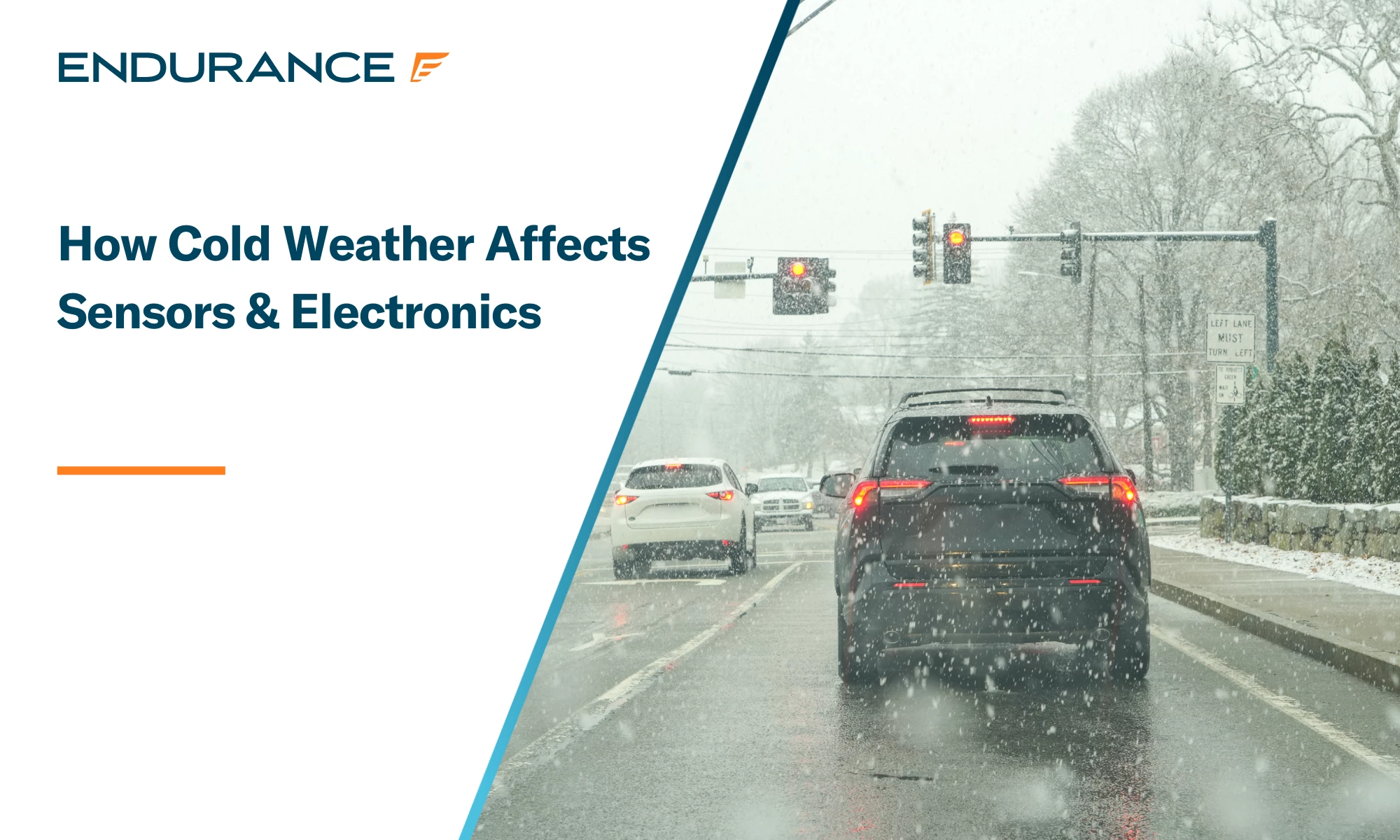Get this deal! Call now.
Speak with a vehicle protection plan specialist and get $300 off any new contract instantly.
Call 866-678-4172
or scan the code below


When the temperatures start to drop and road conditions get worse, there are a lot of hazards that you can come across when you are behind the wheel. If your vehicle has top-of-the-line driver assistance and safety features, you likely feel much safer than you would otherwise. With cold weather, though, these safety systems and their intricate network of sensors and electronics can be affected by changes in electrical resistance, contracting connectors, and magnetic signals.
Knowing exactly how cold weather affects sensors and electronics and what extended warranties cover will help you be ready when the weather turns.
Modern vehicles and their driver assistance systems operate using a series of different sensors throughout the vehicle that are connected to control modules. These sensors look for changes in road conditions, wheel speed, and temperature to activate the different systems. In cold weather, the connectors and circuits that carry information to the control module can be affected. Solder joints, copper wiring, and plastic housings can all become brittle in cold weather, and if you lose a connection, your systems won’t function properly.
The sensors are particularly vulnerable to cold temperatures since they all depend on stable electrical resistance. In extreme cold, the resistance of electrical impulses can fluctuate, and this will prevent your car’s control module from getting the most accurate information. A coolant temperature sensor, for example, might not report the right engine temperature, and the control module might not enrich the air-fuel mixture properly. This, as well as the multitude of other sensors in the vehicle, can result in poor engine function or safety issues on the road.
If your vehicle is equipped with Advanced Driver Assistance Systems (ADAS), it most likely has a variety of sensors, cameras, and radar modules that are constantly gathering information. Features like adaptive cruise control, lane departure warning, and automated emergency braking can all be affected by cold weather. Snow and ice accumulation on front bumpers and grilles can distort the readings of the sensors and cameras, and you might not get an accurate operation of these systems. Misalignment due to impacts with an icy pothole or a curb hidden by snow or rain can also cause your ADAS to go haywire, and if that happens, you won’t be getting the top-notch safety you want from your vehicle.
While the small, sensitive sensors and radar equipment can easily be affected by cold weather, the electrical systems that power them can also be damaged. One of the big issues that drivers tend to face in the winter is a lack of sufficient power to start the vehicle when it has been sitting overnight. This is due to the fact that cold weather can cause significant dips in the charging speed of the battery. The chemical reactions that occur when charging the battery are slowed down when the temperatures are low, so you may not be able to get your car started due to a lack of voltage.
The alternator can also be affected because cold air increases electrical resistance, which will force the alternator to work harder to produce the same voltage. When that happens, there is more of a strain on the moving parts inside the alternator, and you may find that you have to replace it sooner than you otherwise would. The sensors and other control modules may also experience voltage drops due to this increased resistance, and you could end up losing your driver assistance systems when you need them most.
Touchscreens and digital displays have become central to the modern driving experience, and nearly all newer vehicles have some kind of display that can be affected by cold weather. When you turn your heater on after your vehicle has been sitting in the cold for a long period of time, condensation is created, and this small amount of moisture can get behind the LCD or OLED screen and cause damage. Internal moisture can cause corrosion in circuit boards and wiring, and can either short-circuit the electronics or damage the sensitive inner components of the screen. Trapped moisture repeatedly getting into your vehicle’s infotainment system could eventually cause the screen to go blank, and you won’t be able to access your HVAC system or other cabin controls.
When you buy your car new off the lot, it will generally come with a factory warranty that is provided by the manufacturer. This warranty is designed to protect you from design flaws or production issues and typically lasts between three and five years. Once this warranty expires, you will be responsible for any necessary repairs, and an extended warranty or vehicle service contract (VSC) from a third-party provider is your best option. A VSC can help protect you from expensive, unexpected repairs and keep your vehicle running smoothly, even when the weather gets bad.
Every extended warranty provider is different, and each plan will have its own unique set of exclusions and covered components. When searching for a plan for your vehicle, be sure to check for coverage options that include electrical components, infotainment systems, ECUs, and safety equipment. Endurance Warranty’s Supreme plan, for example, covers a wide range of components and systems. These include things like the electrical system and high-tech options, all of which can be affected by weather and need to be protected to keep you and your passengers safe when the temperatures drop.
When freezing temperatures start testing the limits of your vehicle’s most sensitive systems and components, you want to be sure that you have the coverage you need. Endurance offers a variety of plan options that will help give you the peace of mind you need when winter rolls around. Endurance has plans for everything from older high-mileage vehicles to high-end luxury and exotic cars. There are even options for vehicles that other providers won’t cover, such as Canadian Gray Market cars, vehicles with a rebuilt or salvage title, and cars used for commercial purposes like rideshare or delivery.
In addition to the confidence you can get from top-notch coverage, you can also get access to Endurance’s comprehensive suite of benefits and extra perks. These include things like towing services, 24/7 roadside assistance, rental car coverage, and travel interruption coverage. For a small activation fee, you can take your coverage even further with Endurance’s Elite Benefits. This program features extras like tire repair or replacement, key fob replacement, windshield protection, and more.*
If you are ready to give your vehicle the high-quality winter coverage it deserves, get in touch with us at (800) 253-8203 to get a FREE quote. You can also see your price and plan recommendations instantly through our online store.
For more helpful auto expert resources, be sure to check out the Endurance Warranty blog. There, you will find DIY tips and tricks, provider comparisons, mechanical breakdown insurance information for California residents, and much more.

We've received your vehicle information and will contact you shortly with your quote.
— OR —
Start shopping for a coverage plan now.

We're here to make sure you get the most comprehensive EV protection. That's why we've partnered with Xcelerate Auto to offer you transparent and dependable Tesla coverage.
Want us to contact you about XCare coverage for your Tesla?



Your protection is our top priority. Your quote is in progress and you will
receive a confirmation
email shortly.


Speak with a vehicle protection plan specialist and get $300 off any new contract instantly.

Call for $300 off any new plan!
By clicking the button, you consent to Endurance using automated technology to call, email, and text you using the contact info above, including your wireless number, if provided, regarding auto protection or, in California, mechanical breakdown insurance. You also agree to the Endurance Privacy Policy and Terms and Conditions. Consent is not a condition of purchase, and you can withdraw consent at any time. Message and data rates may apply.


Speak with a vehicle protection plan specialist and get $300 off any new contract instantly.
Call 866-678-4172
or scan the code below



Simply fill out the information below and we will follow up fast with your free no-obligation quote.
By clicking the button, you consent to Endurance using automated technology to call, email, and text you using the contact info above, including your wireless number, if provided, regarding auto protection or, in California, mechanical breakdown insurance. You also agree to the Endurance Privacy Policy and Terms and Conditions. Consent is not a condition of purchase, and you can withdraw consent at any time. Message and data rates may apply.

To speak to a vehicle protection plan specialist and get $300 off any new contract instantly
Scan the code below
Since the age of 16, Keith has been immersed in the automotive industry, beginning his career by helping his dad fix vehicles at a young age. Keith now owns his own family-run, ASE Certified repair shop, A+ Autocare. At his shop, he focuses on building trusting relationships with his community through exceptional customer service. Read more about Keith.